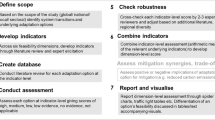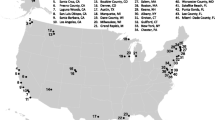Abstract
Many countries are preparing national climate change action plans that describe specific measures they are taking to mitigate greenhouse gas emissions and adapt to the potential effects of climate change. Among the reasons for preparing such plans are that climate change is likely to occur, and many anticipatory measures that would be taken in response to climate change are “no regret” measures that will produce benefits even if climate does not change. Additionally, these plans can serve as communications required by the U.N. Framework Convention on Climate Change. We propose here an assessment process for anticipatory adaptation measures that will enable countries to identify and select measures to adapt to climate change. These measures anticipate potential climate changes and are flexible enough to meet objectives under a wide variety of future climate conditions. The process builds on assessments of vulnerability by focusing on adaptation measures for the most sensitive regions, or populations, within a country. Potential anticipatory adaptation measures are identified, and two or three are chosen based on expert judgment and analysis regarding which measures would produce the greatest benefits and be easiest to implement. Analytic techniques are used to assess the benefits and costs of each of the measures and evaluate barriers to implementation. The measure that is most cost-effective and is easiest to implement is selected. We illustrate the application of the process by examining a hypothetical forest threatened by climate change.
Similar content being viewed by others
References
Asian Development Bank: 1994, Climate Change in Asia: Thematic Overview, Asian Development Bank, Manila.
Benioff R., Guill S., and Lee J. (eds): In press, Vulnerability and Adaptation Assessments: An International Guidebook, Kluwer Academic Publishers, Dordrecht, The Netherlands.
Carter T.R., Parry M.L., Harasawa H., and Nishioka S.: 1994, IPCC Technical Guidelines for Assessing Climate Change Impacts andAdaptations, Department of Geography, University College London, London.
Fankhauser, S.: 1996, The potential costs of climate change adaptation, in: Adaptation to Climate Change: Assessment and Issues, Smith J., Bhatti N., Menzhulin G., Benioff R., Campos M., Jallow B., and Rijsberman R. (eds), Springer-Verlag, New York.
Goklany I.M.: 1995, Climatic Change 30, 427–449.
Gramlich E.M.: 1981, Benefit-CostAnalysis of Government Programs, Prentice-Hall, Englewood, New Jersey.
(IPCC) Intergovernmental Panel on Climate Change: 1995, Climate Change 1995: The Science ofClimate Change, Contribution ofWorking Group I to the SecondAssessment Report of the Intergovernmental Panel on Climate Change, Houghton J.T., Meira Filho L.G., Callander B.A., Harris N., Kattenberg A., and Maskell K. (eds), Cambridge University Press, New York.
(IPCC) Intergovernmental Panel on Climate Change: In press, Scientific-Technical Analyses of lmpacts, Adaptations, and Mitigation of Climate Change, Cambridge University Press, New York.
Lillieholm R.J.: 1993, Preserves at risk: An investigation of resource management strategies, implications and opportunities, in: Preparing for an Uncertain Climate, Vol. 2, OTA-O-567, Office of Technology Assessment, Washington, DC.
Markham A, and Malcolm J.: 1996, Biodiversity and wildlife conservation: Adaptation to climate change, in: Adaptation to Climate Change: Assessment and Issues, Smith J., Bhatti N., Menzhulin G., Benioff R., Campos M., Jallow B., and Rijsberman R. (eds), Springer-Verlag, New York.
Melillo J.M., McGuire A.D., Kicklighter D.W., Moore III D., Vorosmarty C.J., and Schloss A.L.: 1993, Nature 363, 234.
Morse L.E., Kutner L.S., Maddox G.D., Kartesz J.T., Honey L.L., Thurman C.M., and Chaplin S.J.: 1993, The Potential Effects of Climate Change onthe Native Vascular Flora of North America North of Mexico: A Preliminary Climate-Envelopes Analysis, Prepared by The Nature Conservancy, Arlington, Virginia, for the Electric Power Research Institute, Palo Alto, California.
(NAS) National Academy of Sciences: 1992, Policy Implications of Greenhouse Warming, National Academy Press, Washington, DC.
(OTA) U.S. Congress Office of Technology Assessment: 1993, Preparing for an Uncertain Climate — Valume 2, U.S. Government Printing Office, Washington, DC.
Smith A. and Quan Chu H.: 1994, A Multi-Criteria Approach for Assessing Strategies for Anticipatory Adaptation to Climate Change, Decision Focus, Inc., Washington, DC, Unpublished Manuscript.
Smith J.B.: In press a, The Environment Professional.
Smith J.B.: In press b, Water Resources Development.
Smith J.B. and Lenhart S.: 1996, Climate Research 6, 193–201.
Smith T.M., Leemans R., and Shugart H.H.: 1992, Climatic Change 21, 367–84.
Tegart W.J. McG., Sheldon G.W., and Griffiths D.C.: 1990, Climate Change — The IPCC Impacts Assessment, WMO/UNEP Intergovernmental Panel on Climate Change, Australian Government Publishing Service, Canberra.
Titus J.G.: 1990, APA Journal 311, Summer.
(UNEP/WMO) United Nations Environment Programme/World Meteorological Organization: Undated, United Nations Framework Convention on Climate Change, UNEP/WMO Information Unit on Climate Change (IUCC), Geneva, Switzerland.
World Wildlife Fund: 1992, Can Nature Survive Global Warming? Discussion Paper, World Wildlife Fund, Washington, DC.
Author information
Authors and Affiliations
Rights and permissions
About this article
Cite this article
Smith, J.B., Ragland, S.E. & Pitts, G.J. A process for evaluating anticipatory adaptation measures for climate change. Water Air Soil Pollut 92, 229–238 (1996). https://doi.org/10.1007/BF00175568
Issue Date:
DOI: https://doi.org/10.1007/BF00175568




